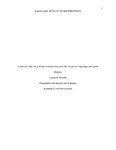Battle of the Macronutrients: A Look into High Fat and High Fructose Diets and Their Impact on Physiology and Spatial Memory (thesis)

View/
Author
Woodie, Lauren Nicole
Subject
Washington and Lee University -- Honors in Biology
Saturated fatty acids in human nutrition
Type 2 diabetes--Nutritional aspects
Fructose in human nutrition
Mild cognitive impairment
Triglycerides
Obesity
Metadata
Show full item recordDescription
Thesis; [FULL-TEXT FREELY AVAILABLE ONLINE] Lauren Nicole Woodie is a member of the Class of 2014 of Washington and Lee University. High fructose corn syrup (HFCS) and saturated fats are two of the main ingredients in the Western-style diet that have been implicated in the etiology of Type 2 diabetes mellitus (T2DM), which is associated with obesity and insulin resistance (1). However, most studies have looked into the effect of the Western style diet as a whole, which involves both high fat and high fructose together. To date, the two have yet to be compared side-by-side in a single research initiative. Therefore, the purpose of the current study is to explore the individual effects that result from a high fructose diet or a high fat diet.
Rats were fed a chow diet of a solid 60% fat, solid 55% fructose diet or a chow diet for 10 weeks. The rats were sacrificed and trunk blood, livers and fat pads were collected. Final serum insulin and triglyceride levels were measured using trunk blood assays.
Animals maintained on the high fat diet weighed significantly more by the end of the study (429.48g ±7.92), had higher percent body weight change (38.16%±0.583), higher body fat composition (3.16%±0.176) and had significantly higher fat pad weight (13.67g±0.902) than the high fructose fed group and the control group. However, the high fructose group had higher serum insulin levels (12.99ulU/mL±7.22) and higher serum total (2.39mg/mL±0.477) and true (0.754mg/mL±0.372) triglyceride levels than any group and exhibited significant cognitive impairments in the reverse Morris Water Maze task.
These data suggest that fat accumulation and weight gain are more influenced by the high fat component of the Western-style diet. However, insulin resistance and elevated triglycerides in the blood are impacted more by high levels of fructose in the diet. Comparative data between a high fat and a high fructose diet in a single study are novel and shed light on the effects two of the individual components of a Western-style diet. Lauren N. Woodie